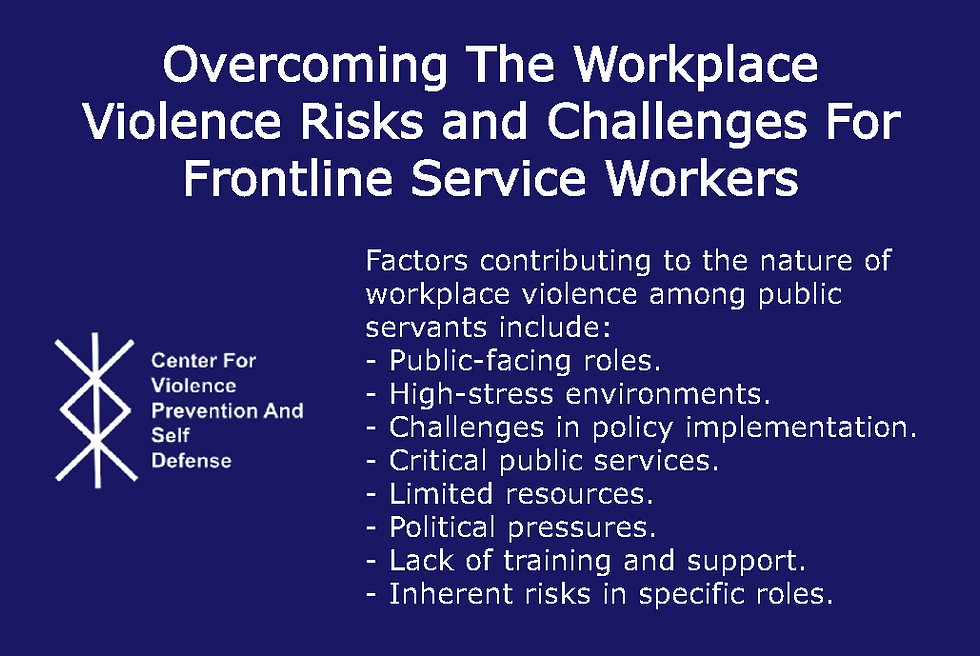Overcoming The Workplace Violence Risks and Challenges For Frontline Service Workers
- william demuth
- Jan 2, 2024
- 4 min read
Updated: Jan 9, 2024
Public service workers are the unsung heroes of our society, playing an essential role in maintaining our social fabric. They are the backbone of our communities, working tirelessly to provide essential services and support to those in need. However, despite their invaluable contributions, these dedicated individuals often face significant risks and challenges in their line of work.

A recent study has shed light on the alarming rate of workplace violence faced by public service workers. The research reveals that workers in social service industries experience a staggering 8.2 percent rate of violent incidents at their workplace, one of the highest rates across various sectors.
This unsettling statistic highlights the need for greater awareness and action to protect these dedicated professionals as they carry out their duties.
Public service workers, such as social workers, healthcare professionals, and educators, often find themselves in high-stress situations that can lead to aggressive behavior from the individuals they serve. The nature of their work often involves dealing with people who are in crisis, experiencing mental health issues, or facing other challenges that can contribute to volatile situations.
These risks are not limited to physical violence. Public service workers also face verbal abuse and threats, which can have long-lasting psychological effects. These incidents can lead to increased stress and anxiety, ultimately affecting the workers' ability to perform their duties effectively.
It is essential for both public and private organizations to prioritize the safety and well-being of their employees. This can be achieved through a combination of measures, such as providing adequate training to recognize and de-escalate potentially violent situations, implementing safety protocols and procedures, and ensuring that employees have access to mental health support services.
The alarming rate of workplace violence faced by public service workers is a complex issue with multiple contributing factors. By understanding these factors, we can work towards creating safer and more supportive environments for these dedicated professionals. It is our responsibility to protect the individuals who dedicate their lives to serving the public and ensuring the well-being of our communities.
Uncovering the Risks: Factors Contributing to Workplace Violence Among Public Servants
Public-facing roles: Many public service workers, such as social workers, healthcare professionals, and educators, interact directly with the public on a daily basis. This constant exposure to individuals in various states of distress or crisis can lead to volatile situations and, in some cases, violent behavior.
High-stress environments: Public service workers often operate in high-stress environments, where they are responsible for managing complex issues and providing critical support to vulnerable populations. The constant pressure and emotional strain of these roles can exacerbate underlying tensions and contribute to an increased risk of workplace violence.
Challenges in policy implementation: Public servants are often tasked with implementing policies and regulations that may not be well-received by the public. This can create tension between workers and the communities they serve, leading to an increased risk of conflict and violence.
Critical public services: The nature of public services provided by these workers, such as healthcare, education, and social support, can be a matter of life and death for some individuals. This heightened sense of urgency and importance can lead to heightened emotions and, in some cases, violent behavior.
Limited resources: Public service workers often face the challenge of providing essential services with limited resources. This can lead to frustration and resentment among the public, which can, in turn, result in violent incidents at the workplace.
Political pressures: Public servants are often caught in the middle of political debates and conflicts. This can lead to increased scrutiny and pressure from various stakeholders, which can contribute to a hostile work environment and an increased risk of workplace violence.
Lack of training and support: Many public service workers do not receive adequate training or support to handle potentially violent situations. This lack of preparation can leave workers vulnerable to physical and emotional harm.
Inherent risks in specific roles: Certain public service roles, such as law enforcement and emergency response, inherently involve a higher level of risk for workplace violence. These workers are often required to intervene in dangerous situations, which can expose them to increased risk of harm.
Overcoming The Workplace Violence Risks and Challenges For Frontline Service Workers
To address the challenges faced by public service workers, it is essential to implement comprehensive violence prevention training programs. These programs should focus on equipping workers with the necessary skills and knowledge to de-escalate potentially volatile situations, recognize warning signs of violent behavior, and foster a supportive work environment.
Addressing this issue requires a comprehensive approach, including training, practical communication, risk assessment, and support mechanisms to minimize the impact of workplace violence in public service settings.
Public service workers play a crucial role in our society, and it is our responsibility to ensure their safety and well-being. By acknowledging the risks they face and taking proactive steps to address them, we can create a safer and more supportive environment for these dedicated professionals. In doing so, we not only protect our public service workers but also strengthen the social fabric that holds our communities together.
Violence Prevention and Self Defense Resources
The Center for Violence Prevention and Self Defense is a non profit 501(C)(3) with a mission to stop violence by educating at-risk people and empower them with the skills needed to protect themselves by providing online and live training.
Through workshops and seminars we educate participants about violence prevention and guide them on assessing risk factors while establishing boundaries in relationships. Additionally practical self defense classes equip people with hands on skills and effective strategies to prevent and intervene in cases of assault.